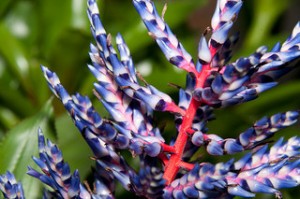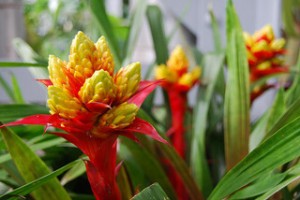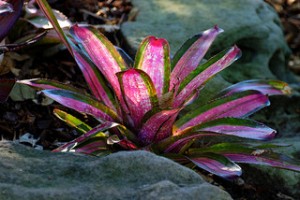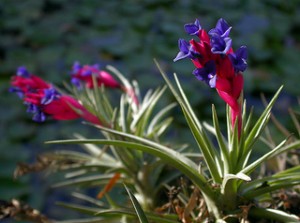How to Identify Your Bromeliad
Author: Melanie Dearringer20 Comments

The bromeliad family consists of many different genera. Leaf and inflorescence appearance can vary drastically among them. Most bromeliads can be identified by either unique leaf characteristics, inflorescence characteristics, or a combination of the two. Below you will find the general characteristics of some of the most popular types of bromeliads. For a more comprehensive guide that includes additional genera, check out our free Bromeliad Identification Flowchart.
Aechmea
Pronounced: eek-mee-uh

-Aechmea ‘blue tango’
- Leaf characteristics
- Margin: spiny
- Color: banded or spotted
- Inflorescence characteristics
- Location: rising above the foliage on a bloom stalk
- Bracts: brightly colored
- Shape: conical, panicle, or cylindrical
- Flowers: small and round
Guzmania

-Guzmania ‘limones’
Pronounced: gooz-mahn-ee-uh
- Leaf characteristics
- Margin: smooth
- Color: greed or red
- Inflorescence characteristics
- Location: on a bloom stalk rising about the foliage
- Bracts: yellow, red, orange, or pink
- Shape: star-like
- Flowers: small and short lived
Neoregelia

-Neoregelia hybrid
Pronounced: nee-oh-reg-el-ee-uh
- Leaf characteristics
- Margin: spiny
- Color: Variety of colors available
- Inflorescence characteristics
- Location: flowers bloom in central tank
- Flowers: small with three petals
Tillandsia

-Tillandsia aeranthos
Pronounced: till-and-see-uh
- Leaf characteristics
- Margin: smooth
- Color: greyish
- Inflorescence characteristics
- Location: an a flower stalk
- Flowers: purple, red, pink, and yellow
Aechmea ‘blue tango’ photo credit: Dwight Sipler via https://www.flickr.com/photos/photofarmer/6631388813/
Guzmania ‘limones’ photo credit: Christina B Castro via https://www.flickr.com/photos/cbcastro/3737710921/
Neoregelia hybrid photo credit: Tony Rodd via https://www.flickr.com/photos/tony_rodd/5131416798/
Tillandsia aeranthos photo credit: Gabriela F Ruellan via https://www.flickr.com/photos/ultimorollo/262670637/
Featured image photo credit: Dwight Sipler via http://www.flickr.com/photos/photofarmer/8595260903/
20 Responses to “How to Identify Your Bromeliad”
Leave a Reply

Resource Download
Hechtia Care Cheat Sheet
Learn how to care for your Hechtia bromeliad with this quick and easy informational guide.
Learn More
Ask an Expert
Questions about bromeliads?
Our experts love a challenge!
Photo of the Week
Submit your photo to be featured on the blog!
More Photo of the Week Winners
Submit Photo








Very excited about growing these plants!
I RESCUED A PLANT THAT MY SISTER IN LAW WAS TOSSING BECAUSE IT WAS “DEAD”. i BROUGHT IT HOME AND REPOTTED IT (NOT PROPERLY, I AM NOW FINDING) AND IT STARTED PRODUCING PUPS. i AM EXCITED NOW AND WANT TO FIND MORE OF THESE BEAUTIFUL GEMS..
Thank you these pics and names help a lot.
I tHInk i have TILLANDSIA, but i can’t be sure, as i did not get flowers but plenty of stamens and pistils have just burst out and are now dying. the card from the store shows a species more like NEOREGELIA, but i don’t trust tht as i have 5 heads coming out of the tank. Please help me identify and then what I can do to care for it as if it is not blooming it can’t be healthy then? 🙁
Kej, Feel free to send us a photo of your bromeliad so we can help you identify and care for it. You can email us at (without the spaces): bromeliads @ bromeliads . info
my plant is dying I don’t know what is wrong please help me she is a beautiful house plant I’ve had her for a bout 5 months but had no instructions on how to care for it.
Do you know what variety of bromeliad you have? What are its symptoms?
I moved into a new home and there was a messy, overgrown planter under a huge oak tree and when I was out there one day I noticed there are tons of bromeliads inside. I was a little disappointed that they were all plain green. If I move them where they can get more light will that help? Or are some just plain green?
Hi! I have a beautiful blue tango, the vivid pink color of the flower has faded to a baby pink color. Does this mean it’s dying? What am I doing wrong? I water once a week and keep it in indirect sunlight. Please help!
The flower spikes die about a month at the least but sometimes up to almost a year (based on my personal experience, research, and knowledge gained at the nursery at which I work). Just cut the stalk that the flower is growing out of as far down as you can without damaging any of the leaves. More will grow. This process is normal. The only thing to worry about is if the LEAVES are dying.
I want to make a exclusive bromiliad garden for that required planting material for different types of Bromilad. I am situated at Uganda, East Africa. Can anyone suggest any source nearby from where I can get quality planting material. I am ready to import from overseas also. Thanks to all.
Does the bromeliads need a lot of sun
Hi Irma, sun amount will depend on your type of bromeliad. A general rule of thumb is the thicker the leaves, the more sun it needs / the thinner and more delicate the leaves, the less sun it needs.
I would like to comment on your very factual and very much helpful statement, however as this rule of thumb is mostly true for Bromeliads, this however IS NOT the general rule for ALL household plants! I would just hate to think of any viewers who are inexperienced plant owners use your comment as the general rule of thumb for all plants because every species varies GREATLY in the plant kingdom and the amount of sun it recieves! The variance of sunlight required by plants is dependent on species and natural habitat! Thanks for that great tip though! It was very helpful!
How much water?
During the hot summer months they love to be misted frequently, i always water my Bromeliads in the center of the plant where the new leaves form in the center of the plant. There is a reservoir in the middle of the plant where not only does it produce its new vegetation but also in it’s natural habitat would fill up with the rain or morning dew will trickle down into the base of the plant. Its a good idea to always keep it full and your Bromeliad will sip throughout the day. Try not to water around the plant where it is affixed, this will cause rot and your plant may die. Generally speaking, the Bromeliads like to attach them selfs to other plants in there natural habitat thus know root system they aquire there water as it drips or trinkles down its leaves! What a beautiful design nature had in mind! Quite efficient to i might add! This same technique is performed the same way with any of its offspring (AKA, PUPS!)
I am wanting to know which Bromeliad I have I can send a pic but there is no way to do that here. The inflorescence have the appearance of very small garlic clove. I am guessing this is the seeds… or has it not bloomed? The foliage is green and grey zebra striped with spines on the edges. This was a rescue plant from a friend that was moving out of town and does not remember what the inflorescence looks like or the identification is.
I was gifted a plant that I think is a bromeliad, but I don’t know what type it is. I want to help it flourish, but it seems that different types have different care needs. Please help, I am not experienced with plants and I don’t want it to die because I really like it. It is about a foot tall, with green leaves that go out sideways about two feet, and has a tall but slim pink flower. I tried to include a picture, but it doesn’t seem to be able to be added to the text box.
The flower inside my neoregelia has died and become a little moldy, but the rest of the plant is fine. There is also a sizeable pup growing off it and a very small new one coming off the main plant.
How should I treat the main plant to get rid of the mold in the center cup with the flower? thanks!
I have a bromeliad that has solid red on bottom side of leaf. The top leaves are green and red. Flower come out on long stem, with small white and purplish flowers. Also has some nasty teeth running down the leaves.